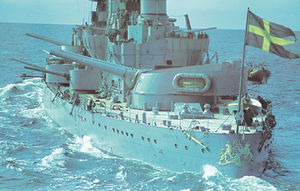Bofors
The name Bofors has been associated with the iron industry for more than 350 years.
Located in Karlskoga, Sweden, it originates from the hammer mill "Boofors" founded 1646. The modern corporate structure was created in 1873 with the foundation of Aktiebolaget (AB) Bofors-Gullspång. A leading Swedish steel producer by the early 1870s, it expanded into weapons manufacture when steel produced via the Siemens-Martin process started to be used for this purpose. The company's first cannon workshop was opened in 1884. Bofors' most famous owner was Alfred Nobel who owned the company from 1894 until his death in December 1896. He had the key role in reshaping the iron manufacturer to a modern cannon manufacturer and chemical industry. The powder manufacturer AB Bofors Nobelkrut, later an explosives and general organic-chemical producer, was created in 1898 as a wholly owned subsidiary. By 1911 AB Bofors-Gullspång had outcompeted, bought and closed down its Swedish competitor in cannon manufacture in Finspång. The company's name was shortened to AB Bofors in 1919.
In 1999 Saab purchased the Celsius Group, then the parent company for Bofors. In September 2000 United Defense Industries (UDI) of the United States acquired Bofors Weapons Systems (the heavy weapons division), while Saab retained the missile interests.
Thus Bofors is today split in two parts:
- BAE Systems Bofors (BAE Systems acquired United Defense and its Bofors subsidiary in 2005)
- Saab Bofors Dynamics
The name Bofors is strongly associated with a 40 mm anti-aircraft gun based on a Bofors design which was produced and used by both sides during World War II, and often called simply the Bofors gun. The gun saw service on land and sea, and became so widely known that anti-aircraft guns in general were often referred to as Bofors guns. Another well-known gun made by the company was the Bofors 37 mm anti-tank gun, a standard anti-tank weapon used by a variety of armies early in the war. It was built under license in Poland and the USA and was also used in a variety of tanks, including the 7TP and M3A3 Stuart.
In recent years Bofors has lost much of its reputation in Sweden due to various suspect affairs,[citation needed] the most scandalous being the alleged but never proven kickbacks involved in securing a contract with the Indian Army in 1986.
See also
External links
| 40x40px | Wikimedia Commons has media related to Bofors. |
- All articles with unsourced statements
- Articles with unsourced statements from May 2010
- Articles with invalid date parameter in template
- Pages with broken file links
- Commons category with local link different than on Wikidata
- Companies established in 1646
- Companies established in 1873
- Defence companies of Sweden
- Defunct companies of Sweden
- Bofors
- 2Fix
